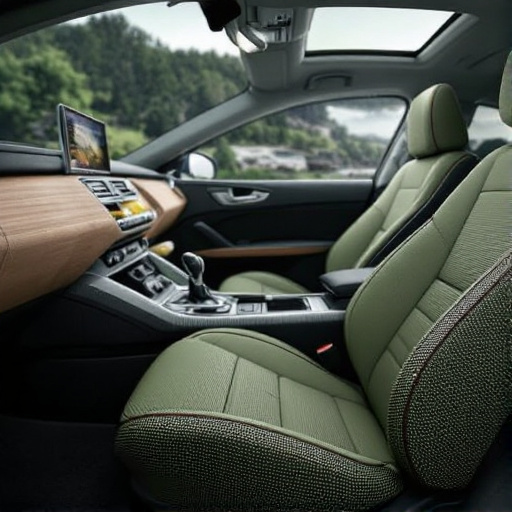Related Articles
- Charged Up! How Electric Vehicles are Reshaping Urban Wildlife Habitats and Biodiversity
- Navigating the Used Car Market: Uncovering the Secrets of 'As-Is' Sales for Savvy Buyers
- The Rise of Electric Car Pop-up Shops: A New Frontier for Urban Retail Experiences
- The Forgotten Art of DIY Car Maintenance: Rediscovering Skills in a Tech-Driven World
- Electric vs. Vintage: The Battle for Enthusiasts' Hearts in the Age of Latest Car Models
- The Rise of the 'Car Review Influencer': How Social Media is Shaping Auto Buying Decisions
The Rise of Sustainable Car Interiors: Exploring Eco-Friendly Materials in the Latest Models
The Rise of Sustainable Car Interiors: Exploring Eco-Friendly Materials in the Latest Models
The automotive industry is undergoing a significant transformation, with sustainable car interiors leading the charge towards environmentally friendly driving experiences. This article delves into eco-friendly materials and innovations reshaping how we think about vehicle interiors.
The Shift Towards Sustainability
Once considered a marketing gimmick, the move towards sustainable materials in car interiors has gained traction, nearly doubling in significance over the last decade. According to a report by McKinsey, the global market for sustainable automotive materials is projected to reach $29 billion by 2025, with manufacturers acknowledging the urgent need to reduce their environmental impact.
The Materials Revolution: What’s in Your Car?
When you step inside a modern vehicle, you might expect plush leather seats and shiny plastic dashboards. But increasingly, consumers are being introduced to a range of exciting, eco-friendly materials that are both functional and stylish. Just a few examples include:
- Recycled Plastics: Many brands are using plastic waste retrieved from oceans and landfills, transforming it into durable upholstery and trim.
- Bio-based Fabrics: Natural fabrics like hemp, organic cotton, and even innovative materials made from mushrooms are making their way into the automotive interior, offering a touch of nature without sacrificing comfort.
- Leather Alternatives: Brands like Tesla and BMW are turning towards materials like Piñatex, a leather alternative made from pineapple leaf fibers, that boasts both sustainability and high quality.
A Personal Touch: The Eco-Conscious Consumer
As a 27-year-old writer, I find it fascinating to witness this change in consumer preferences firsthand. When I was younger, environmental concerns often felt like a distant problem, something for the future. But my friends now actively look for brands that align with their values, emphasizing sustainability and eco-friendliness in their purchasing decisions.
Take, for example, the rise of the Ford Mustang Mach-E, which features eco-friendly materials in its interior design, offering vegan leather options and recycled plastics. This level of consideration speaks volumes about how consumer expectations have evolved. According to a study by Deloitte, 64% of young consumers are willing to pay more for brands associated with sustainability.
Case Study: BMW’s Sustainability Strategy
BMW has positioned itself as a pioneer in sustainable car interiors. The company's long-term goal is to reduce their carbon footprint significantly. For instance, the BMW i3 features interiors made largely from sustainable materials, including recycled plastic and natural fibers. This commitment has not only improved their sustainability ratings but has also appealed to a growing demographic that prioritizes eco-consciousness.
Bridging the Gap: Education and Awareness
Despite these advancements, many car buyers still know little about the materials in their vehicles. Some might be surprised to learn that upholstery made from recycled materials can feel just as good as, if not better than, traditional counterparts. Automakers are propelled to tackle the education gap by embracing transparency about their materials. You would think that if it’s eco-friendly, it might as well come with a marketing campaign, right? Joke’s aside, a little more information goes a long way for consumers.
The Economic Impact
Let’s discuss the economics of sustainable interiors. The initial investment into eco-friendly materials might seem higher, but the long-term benefits can outweigh these costs. A report by the World Economic Forum estimates that adopting sustainable practices can lead to cost savings of up to 20% in the manufacturing process. It’s a win-win situation for manufacturers and consumers alike, advocating for a more circular economy.
The Future of Sustainable Interiors
As we peer into the future, we can expect even more innovative materials and designs in car interiors. Imagine a car where the seat upholstery is made from algae or where the dashboard consists of biodegradable composites. The possibilities are virtually endless!
Moreover, the integration of advanced technology will ensure that these sustainable materials do not compromise on functionality. For example, companies like Mercedes-Benz are experimenting with “smart” materials that adjust to changes in temperature, promising to merge comfort with sustainability.
What’s Driving This Change?
Several factors fuel the rise of sustainable materials in car interiors:
- Climate Change Awareness: Heightened awareness about climate change is prompting consumers to seek out greener alternatives.
- Regulatory Pressures: Many governments are imposing stricter regulations on carbon emissions, pushing companies to consider more sustainable solutions.
- Technological Advancements: Innovations in material science are making eco-friendly options more efficient and appealing.
Humorous Conclusion: The Future is Bright (and Green)
In summary, as we continue down this sustainable path, expect more exciting innovations. Maybe one day our cars will run on air, and we’ll sit on seats made of marshmallows! Okay, maybe that’s a bit far-fetched, but the core idea stands: the future of car interiors is bright, innovative, and increasingly green.
So, whether you're a 16-year-old starting to dream about your first vehicle or a 70-year-old enjoying a cozy ride, the shift towards sustainable automotive interiors is reshaping the way we engage with cars. You never know, your dream car could very well be an eco-friendly marvel, blending luxury with planet-friendly practices!





